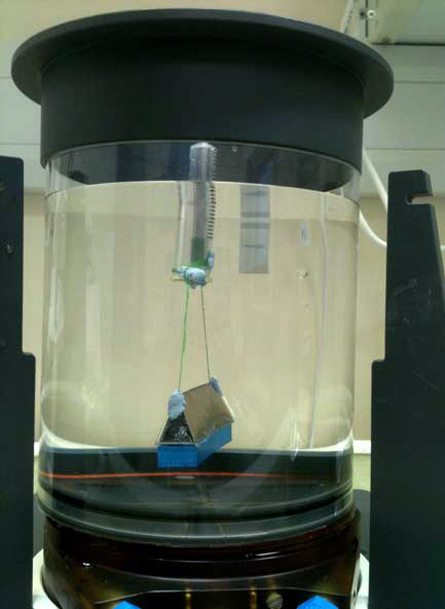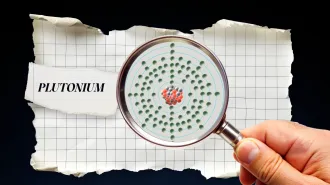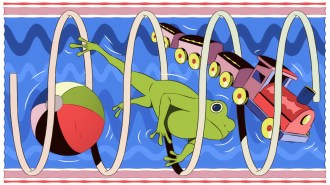
BEAM ME IN At left, waves (yellow dashed lines) from a regular beam of light or sound tend to bounce off an object (blue arrows) and deliver a subtle push. Waves from a new tractor beam, illustrated at right, bounce off the sides of an object and rebound upward. As a result, the object gets pulled toward the source of the beam.
M. Atarod
Tractor beams have hit the big time. A newly constructed device generates a beam of concentrated sound that, for the first time, exerts a continuous, perceptible tug on objects large enough to see. The researchers didn’t actually reel in an object, but they demonstrated that an ultrasound tractor beam could do the job.
Using a tractor beam to haul a damaged spaceship may look simple on Star Trek, but nature makes it very difficult to pull objects from a distance. Waves of light or sound fired at an object tend to bounce off its surface like raindrops on an umbrella, collectively exerting a subtle nudge called radiation pressure that pushes the object away.
Christine Démoré, an engineering physicist at the University of Dundee in Scotland, and colleagues set out to reverse the direction of that radiation pressure, so that an object would get pulled rather than pushed. Their goal was to sculpt a beam of sound waves to bounce off the target and then scatter in the direction opposite from the source of the beam. As a result, the object would get shoved backward, toward the beam’s source.

When they turned on the machine, the pillars’ rapid motion generated waves of pressure that combined to form a beam of sound (though beyond the range of human hearing). The pillar array sent out sound waves from each end. That enabled the two segments of the beam to converge on the target from the sides, and not from the bottom. Sure enough, the sound rebounded off the sides and scattered upward. Although the suspended target couldn’t go very far, it visibly inched downward and tugged on the thread. A scale measured that pull and confirmed that the net force acting on the target was directed straight down, toward the ultrasound machine. A paper detailing the tractor beam will appear in Physical Review Letters.
“It’s a big step forward,” says New York University physicist David Grier. However, he would have liked to see a demonstration of moving an object all the way to the tractor beam’s source. Démoré says her group hasn’t run that experiment yet because it requires constructing a target that won’t float or sink on its own. “We haven’t fully done the Star Trek thing where we bring something in to the ship,” she says.
In 2010 Grier built the first tractor beam, a light-based version that yanked microscopic objects about the size of a bacterium backward nearly 10 micrometers (SN Online: 3/10/11). Unlike Grier’s device and subsequent iterations, this new tractor beam can tow objects visible to the naked eye because sound applies much more force than light. It also exerts an uninterrupted force as the object approaches the beam’s source. “This is more like the tractor beams in sci-fi movies,” says coauthor Patrick Dahl, who is now an engineer at Sonoscan outside Chicago. “It continuously pulls things in.” And while this experiment used targets of optimal shape, Dahl says the technique should work with spheres and other shapes.
Unfortunately, sound can’t travel through a vacuum, so this tractor beam will never round up space junk or aid space walking astronauts. (Grier is working with NASA to develop optical tractor beams for space applications.) But acoustic tractor beams could prove useful in environmental sampling, Grier says, allowing scientists to analyze a chemical or geological sample without risk of contaminating it by touching it. Dahl hopes the technology could also help with noninvasive surgery, allowing doctors to steer concentrated sound waves around ribs to destroy tumors. “The potential is there to do some pretty great things,” he says.







